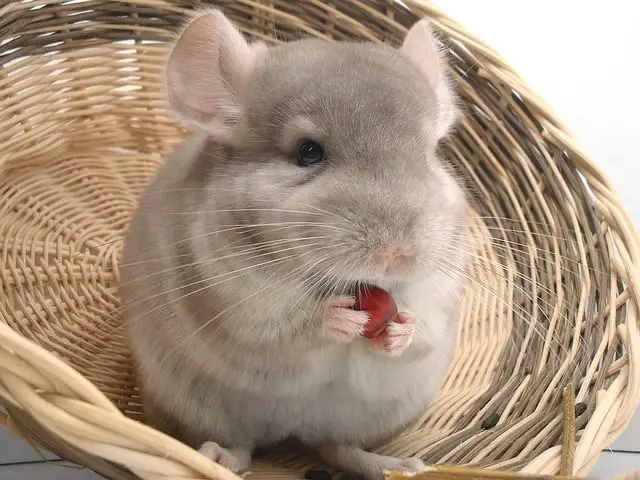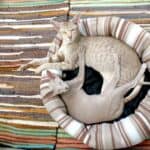
Chinchillas , small pets: physical and temperamental characteristics for those who want to know more about how to raise them at home.
The chinchillas are mammals that are part of the ‘ order of Rodents and the Cincillidi family. Originating from the Andes mountain range , in South America, to adapt to the freezing winters at high altitudes (between 3000 and 6000 meters) they have developed a very thick fur.
There are two different species: the Chinchilla lanigera (lowland, more common) and the Chinchilla Brevicaudata (mountain). Both are tameable.
Since the Inca Empire they were bred for their furs, a market that remained illegal until recently. In 1910, a decree was issued that prohibited its sale throughout South America.
Today the chinchilla is a protected species that has spread to Italy only since the 90s.
Chinchilla: physical characteristics
Chinchillas have a squirrel-like appearance but move more like rabbits.
This animal is particularly long-lived, since it also lives up to 20 years if kept in a cage, otherwise it reaches 10-15 years . They are very resistant to diseases and rarely develop pathologies, with the exception of some gastrointestinal problems .
They are 22-35 cm long , excluding the tail which alone is 7.5 to 15 cm long. The coat is very thick and soft : think that each follicle generates up to 50 hairs! The colors range from gray to white to black . A curiosity: when they are scared of something, they tend to lose hair.
As soon as they are born they are very small and weigh no more than 50 grams, then they even reach 800 grams in adulthood. In this species, it is the females that are larger .
The muzzle is conical in shape, with round, brown or red eyes. The ears resemble those of a mouse and through them the animal is able to regulate its body temperature. The most developed senses are smell and hearing, while sight is somewhat poor.
Nature of chinchilla
They are nocturnal animals , so they are perfectly able to move in the dark thanks to their large eyes and ears. It is also said that the chinchilla is a crepuscular animal , that is, it activates at dusk. During the day you often find him sleeping. He does not like being pampered, or rather he is not always willing to be caressed.
The character is inherited from its parents, but also basically depends on the education received in case it is bred in captivity. What distinguishes it is certainly its great liveliness and energy : it runs, plays, nibbles whatever it finds between its paws.
He rarely bites , he’s not a bad animal. On the other hand, his cleaning practices are known : he does his business only inside the cage and does not like to dirty around. Besides, the needs are completely odorless.
Chinchillas also emit noises , which change according to what they want to communicate: they may be more or less strident and acute, but over time you will learn to recognize them.
How to raise a chinchilla?
If you decide to raise a chinchilla indoors, there are a few things to know. For the feeding you have to be very careful , because they are quite delicate. They need to eat a lot of fiber, so their diet will be based mostly on hay, some fruits, vegetables and cereal flours.
It is a herbivore animal and the correct diet is essential for its well-being.
Some advice on the cage
The ideal cage should be large enough for him to jump and run freely . We suggest an aviary type cage, developed in height and with 2 floors. Prefer those of the metallic type, to prevent it from gnawing.
It is recommended to place it not exposed to drafts and protected from the sun . The animal is in fact likely to suffer heat stroke easily. It is necessary to ensure the presence of a specific sand in which it can roll to promote the well-being of its fur. In the cage, in addition to food and water, a small house should also be placed, preferably high up, in which he can shelter. In nature, in fact, it would live hidden in the rocky cavities during the day and then go out only when darkness falls. Finally, they cannot miss the games (such as a wheel, pipes or boxes) to guarantee them the possibility of keeping active.
Therefore, place the cage in an area of the house that is not too exposed to noise during the day and evaluate the position also by virtue of the presence of other pets, which could bother it.
The chinchilla loves to roll in the sand , where it can clean and polish its coat, eliminating excess sebum. For this reason, remember to clean the tray daily. As anticipated, they are nocturnal animals, so you will surely hear some noise at night.
Be careful not to impose your presence immediately, let him slowly gain confidence otherwise you risk only frightening him.
Leaving it free at home means taking the risk that it can nibble on tables, chairs and so on. It is possible to educate him calmly, but always remember that this is not a dog and that his needs are completely different.
Watch out for the temperature
Finally, it must be borne in mind that temperatures above 26 ° risk endangering their very life . Consider carefully where to place the cage, avoiding areas where direct sunlight arrives. The risk of heatstroke is always around the corner.
Chinchilla when it lives
Domestic specimens have a much longer life expectancy than wild ones. As pets in the home they tend to live to be around 10-15 years . Cases of 25 years of age have also been revealed. The life expectancy of these small rodents is obviously closely linked to the conditions in which they live.
Ensuring the absence of stressful situations, good nutrition and the right physical exercise is essential in this regard. The emotional health of this little animal is also ensured by encouraging a period out of the cage throughout the day. For this, it is necessary to ensure a safe and harmless area in which to leave the specimen free to move and explore.
Price chinchilla
Chinchillas are available in specialized pet stores and cost from $150 50 $350. The price goes up according to the color of the hair, which can be more or less valuable.






